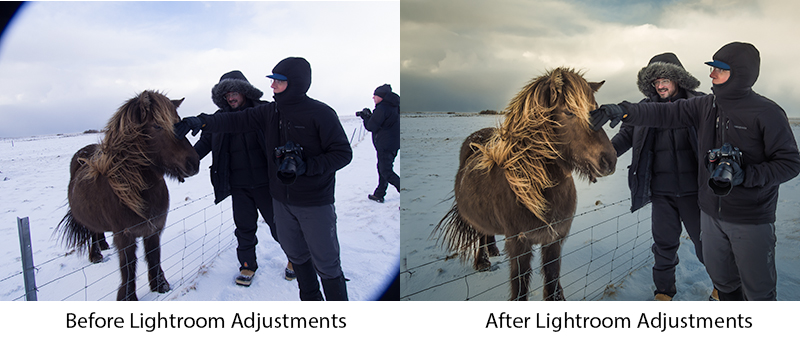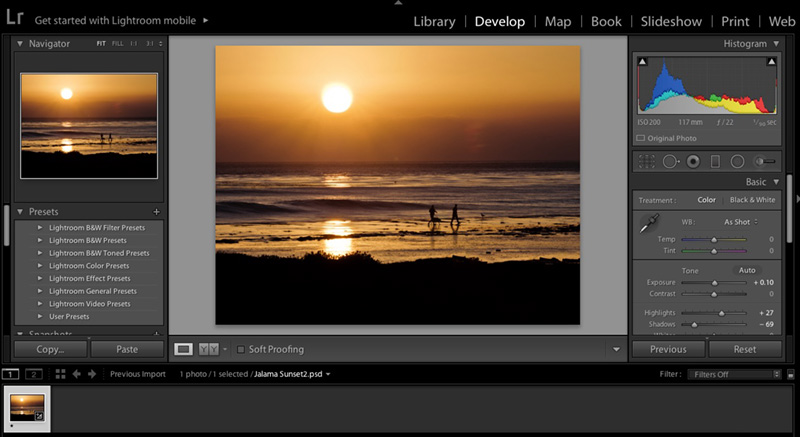Are you spending a lot of time learning your digital camera? Maybe you’re getting up early to shoot at just the right location, in just the right light? Are you getting the results you hoped you would? You’re not?
Learning effective photo processing with a program like Adobe Photoshop Lightroom is easily half of the skills you need to create amazing images with your digital camera.
I have been using Adobe Photoshop for many years, but have recently converted to doing the bulk of my editing in Adobe Photoshop Lightroom. Lightroom is a powerful program that offers you easy adjustments to push your editing and your photography from good to great.
Advanced digital cameras have come a long way to getting you properly exposed images, but if you don’t know some simple editing techniques, you will be not be getting the maximum out of your camera.
Why do I like Lightroom so much?
Lightroom not only offers amazing advanced editing techniques, but also gives you the ability to easily organize your whole catalog of pictures with a series of tags, star, and flag ratings. When you first import your images into Lightroom, you can set up your ratings on your favorite images, and never lose them again. I am now able to find a single image that is in my Lightroom catalog in a matter of seconds. (I now have over 30,000 images in my catalog.)

I have this great camera, why do I need photo editing programs like Adobe Photoshop or Lightroom to create a finished image?
Many of my clients purchase the newest, neatest camera, thinking it will give them the quality images they want. Sometimes it does the trick, sometimes it does not. Yes, it takes a lot of effort to learn Photoshop or Lightroom, but these programs are so powerful, once you get the basic tools, you won’t want to go back. The advanced DSLR cameras these days give you an option to create JPG images that automatically have preset settings as far as color, saturation and sharpening. If you compare a JPG image and a RAW image you will see the difference. The JPG may look bright and saturated, where the untouched RAW may look flat and lifeless. Why is that?
That’s because when you shoot in JPG, you are letting the camera make the creative decisions for you.
You have some control over in camera processing of JPG images. You can go into your internal settings of your camera and increase saturation or brightness to your liking, but are you really taking creative control of your images?
When you shoot with a RAW file, you can non-destructively change the white balance, color contrast, and saturation to your liking in Lightroom. If you decide to change these settings with a JPG file in post processing, with every adjustment, you are affecting the quality of the image and are losing resolution. At the very least, work with a TIFF file, where it has LOSSLESS image adjustment.
If you have pre-visualized your picture when you take it, you will have a good idea of where you would like to go with this picture in post processing.
Why doesn’t the camera catch what I see?
A digital camera can only read a certain range of light and gamut of color. By using post processing, you are allowing the image to reflect exactly what you saw at the scene, or what you visualized when you took the picture. The trick here is to not over saturate, over sharpen, or generally overdo the editing process so it looks fake or cartoonish. But if that is your creative vision, then go for it!
How do I get there?
Practice, practice, practice. Take a good beginning course like my Lightroom Quick Start Class, or get a mentor who can help you with the process. If you are serious about your photography, you will be happy you did.
If you are ready to learn more about this powerful program, join me for my Lightroom Quick Start class. This is the clearly the other half of creating amazing images. Once you have learned the workings of your digital camera, it is now time to learn how to effectively edit in a program like Adobe Photoshop Lightroom.
 Holly Higbee-Jansen is a passionate photographer and photo workshop leader, and has been exploring her fascination with light since she was a young child. As a co-owner and guide for www.JansenPhotoExpeditions.com, she loves taking small groups of clients to beautiful places to help them explore their photographic creativity. Join them on one of their photographic workshops in iconic locations in the American West and Iceland. Live life creatively!
Holly Higbee-Jansen is a passionate photographer and photo workshop leader, and has been exploring her fascination with light since she was a young child. As a co-owner and guide for www.JansenPhotoExpeditions.com, she loves taking small groups of clients to beautiful places to help them explore their photographic creativity. Join them on one of their photographic workshops in iconic locations in the American West and Iceland. Live life creatively!
Reach Holly by email at: [email protected] and read her blog at: JansenPhotoExpeditions.com/Blog
BPSOP Instructor – Holly Higbee-Jansen
Holly Teaches:











